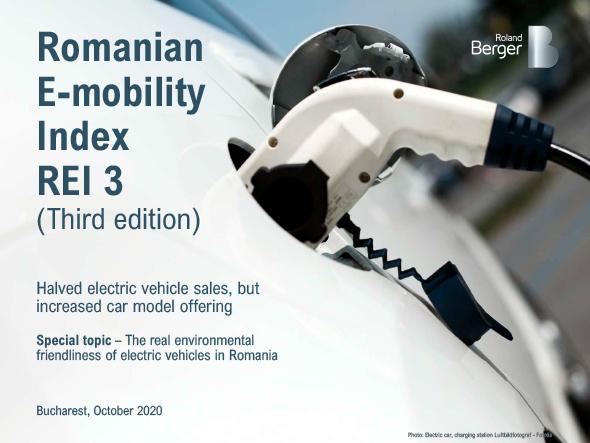Romanian E-Mobility Index: Electric vehicle sales plunge
![{[downloads[language].preview]}](https://www.rolandberger.com/publications/publication_image/652_roland_berger_romanian_e_mobility_index_cover_download_preview.jpg)
Third edition of the Romanian e-mobility Index showcases the real environmental friendliness of electric vehicles in Romania.


The level of transparency with regards to the e-mobility ecosystem within the Romanian market remains relatively limited. Key questions such as ...
… remain largely unanswered. The Romanian e-mobility index (REI), a bi-annual report, aims to bridge this gap related to e-mobility by offering a data-driven perspective, centered around the major developments of the local market as well as related technologies.

"Electric vehicles operating in Romania actively contribute to a reduction in harmful emissions"
The amount of greenhouse gas emissions generated by a vehicle over its entire lifecycle includes not only the emissions from its operation, but also the emissions generated during vehicle production and recycling.
Electric vehicle production is particularly carbon-intensive, generating almost double the greenhouse gases emitted to produce an equivalent conventional vehicle, mainly as a result of the energy-intensive production process for the large battery packs.
However, unlike their internal combustion counterparts, electric vehicles have zero tailpipe emissions during usage. They indirectly pollute the environment through greenhouse gases emitted by the power plants/ installations producing electricity – Energy generation is actually the main polluting element of EVs. Hence, the environmental success of these vehicles over their entire lifecycle largely depends on being powered by low emission electricity generation.
Romania's generation mix has a significant share of electricity from hydroelectric and other renewable sources – 40 to 45% of the electricity generated in the 2016-2019 period was from these sources. As a result, a compact EV is 40% more environmentally friendly than a compact internal combustion car over a vehicle life of 300,000 km. This allows an EV recharging in Romania to compensate for its high production emissions and break even in terms of carbon footprint with its internal combustion counterpart after only ~70,000 km of vehicle usage. On the other hand, in countries more heavily reliant on coal-based electricity generation such as Germany, the breakeven point is at ~100,000 km, whereas heavy coal users such as Poland risk never breaking even.
New xEV registrations declined by 35% in the first half of 2020 compared to the second half of 2019, to a total of ~880 units. Sales of EVs were most impacted with a ~45% reduction, leading to ~600 new registrations in the first half of 2020. Romania has also lost momentum in terms of share of xEVs out of total new registrations, with a 1.8% figure which place it significantly behind the EU average of 6.9%, being overtaken by key European players such as Spain or Italy.
The end of the first half of 2020 saw the first slowdown in the steady bi-annual rate seen in the last years, dropping from ~30% to ~20%. As a result, the charging infrastructure in Romania expanded to a total number of ~480 stations at the mid-year point.
Bucharest & Ilfov encompass almost a third of the national charging infrastructure, whilst good growth can be observed in Western part of the country. Fast charging capabilities remain limited, with only ~25% of all stations capable of charging at powers above 22 kW, whilst the maximum installed power is 50 kW.
Almost 1 in 5 vehicle models available for purchase in Romania at the end of the first half of 2020 were xEVs. The EV & PHEV offering has shown significant growth in this past semester to a total number of 72 models offered as part of dealerships' portfolios.
Although more body styles are offered per car brand, the offering is still limited for customers with high brand affinity, with only 2 manufacturers offering 9 xEV models.
2020 Rabla Plus governmental incentive scheme offers 45% more funding than in 2019, to a total amount of EUR 29 m funding offered for subsidized xEV purchases. The support scheme is highly popular, considering that the funding pool for private individuals was almost fully utilized by mid-year, although applications opened in March.
About Romanian e-mobility Index (REI): REI is a bi-annual report that aims to increase the level of transparency with regards to the e-mobility ecosystem within the Romanian market by implementing a data-driven perspective, centered around the major developments, as well as related technologies.
Would you like to know more about the Romanian E-Mobility Index and how companies can profit from the development of e-mobility in Romania? Please don't hesitate to contact our experts Szabolcs Nemes or Dragos Fundulea .
![{[downloads[language].preview]}](https://www.rolandberger.com/publications/publication_image/652_roland_berger_romanian_e_mobility_index_cover_download_preview.jpg)
Third edition of the Romanian e-mobility Index showcases the real environmental friendliness of electric vehicles in Romania.